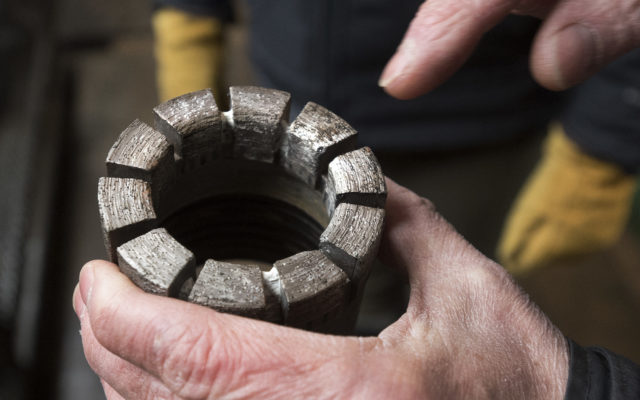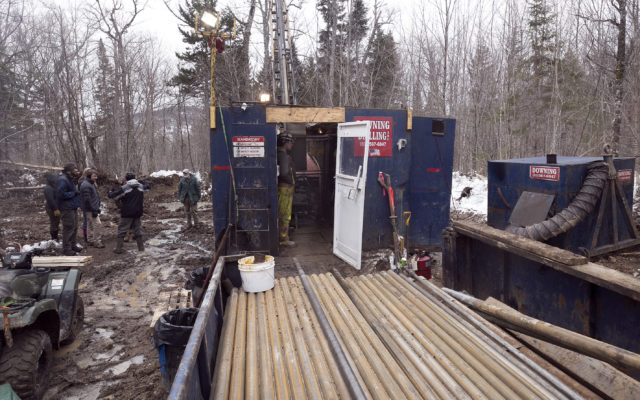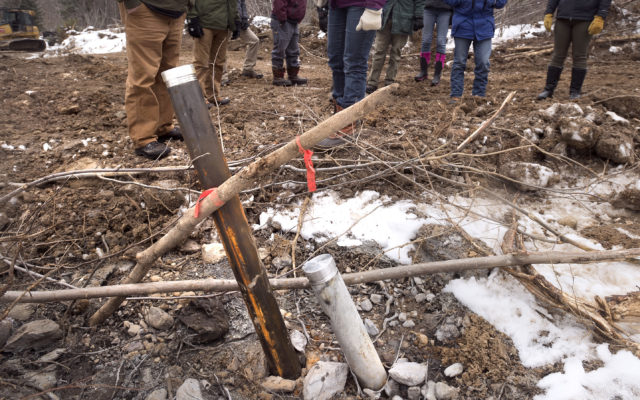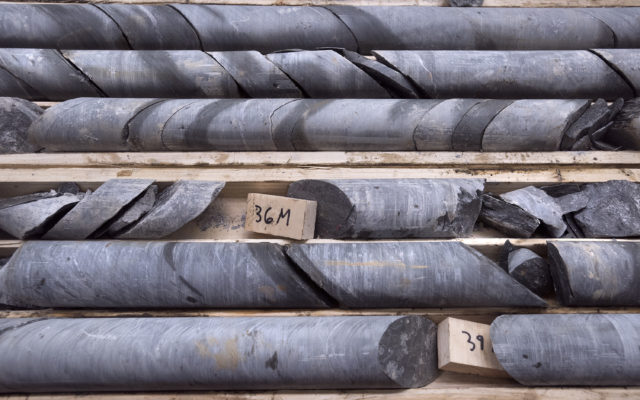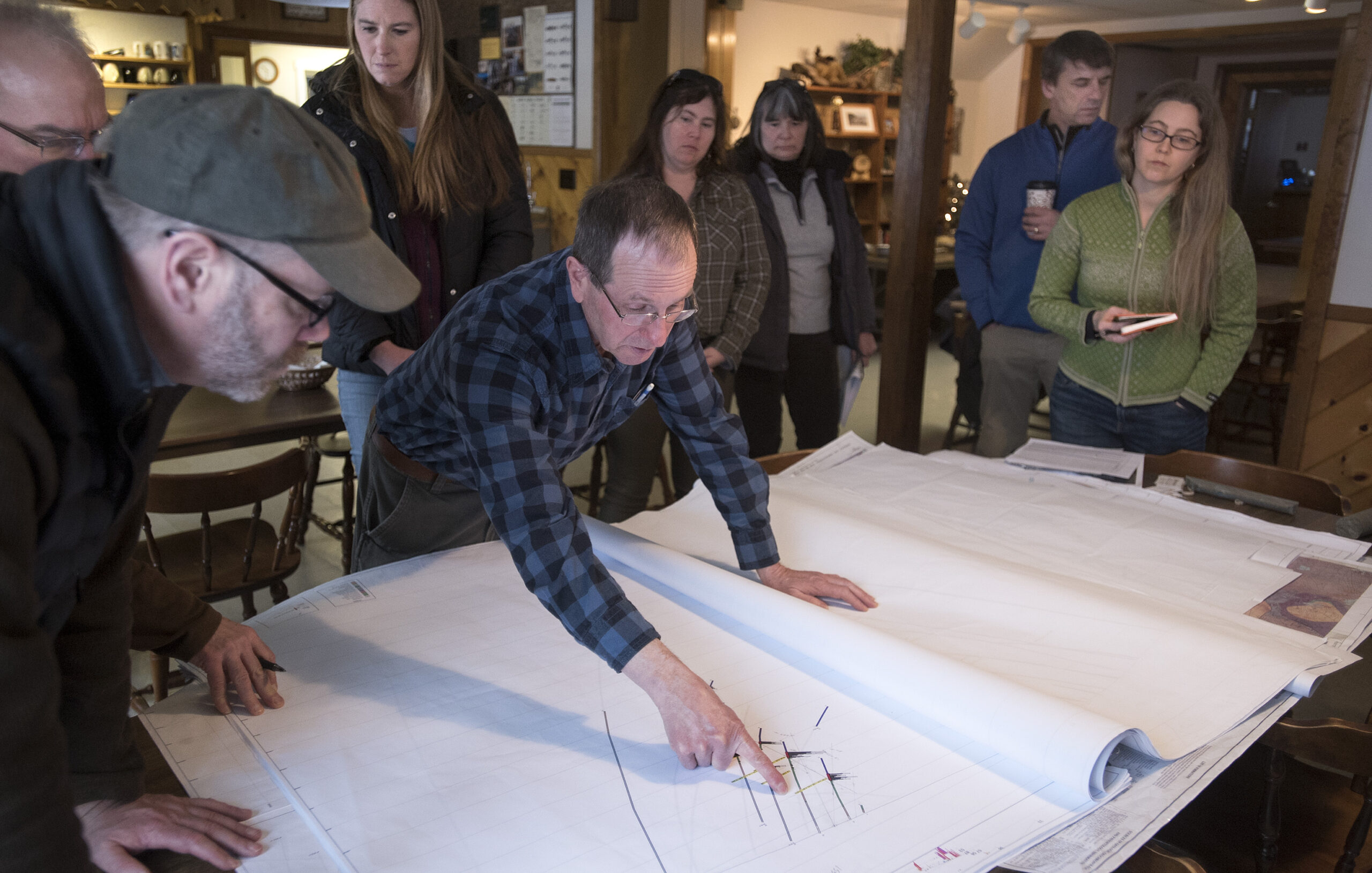
PATTEN, Maine — Since last December, Wolfden Resources geologist Art Hamilton has been studying drilling samples from 500 million-year-old volcanic rock near Pickett Mountain in northeastern Penobscot County.
Through the end of the year Hamilton and Wolfden’s team of contractors will be taking more than 32,000 feet of 2 1/2 inch diameter core samples of the Pickett Mountain deposit to determine whether it is economically feasible to develop what would be the state’s first large scale metal mining operation in about five decades. The longest hole so far has run almost half-a-mile deep.
“Drilling is a very expensive process, especially when you’re trying to go down in depth,” Hamilton said during a tour on March 7 of the drilling site with staff members from the Maine Department of Environmental Protection and other agencies.

During a tour of drilling and processing facilities on March 7, representatives of various state agencies examine core samples collected by the Ontario-based Wolfden Resources Corp. north of Patten. The company began test drilling near Pickett Mountain in December and has collected about 10,000 feet of samples that will help researchers analyze the feasibility of opening a mine near Pickett Mountain in remote northern Penobscot County. They are primarily looking to mine zinc, but lesser amounts of copper, lead, silver and gold were also present in the deposits. (Gabor Degre | BDN)
The $1 million-plus exploration project at the 6,870 acre Pickett Mountain property could mark the beginning of the first new mining activity under the state’s new mining law. However, Ontario-based Wolfden would be “several years at the earliest” from starting a mine and would face a range of permitting requirements in addition to economic feasibility.
“There’s lots of hurdles to get through if we’re ever going to see this into production,” said Hamilton, who has spent much of his career working in the Bathurst mines in northern New Brunswick.
The first hurdle is determining if the volcanic deposit has high-grade concentrations of minerals such as zinc, lead, copper and silver. By the end of the year, Wolfden will complete a resource estimate for the potential of an underground mine at the site, Hamilton said.
The site was previously explored by other mining companies who drilled 100 holes in the 1970s and 1980s but did not pursue any mining projects. The presence of the metals was first noticed during soil samples and in some places the volcanic deposit rises to the surface, while elsewhere it may be half-a-mile or more deep. Hamilton said.
Wolfden is now examining samples from the old holes and drilling new ones. So far, the team has taken about 10,000 feet of samples that are being analyzed and catalogued at a workshop in Patten, and later this year researchers will be using geophysical imaging equipment to try to map out the contents of the deposit, Hamilton said.
Company CEO Don Hoy, who was attending a mining convention in Toronto during the March 7 tour, has said that the Pickett Mountain deposit could be “one of the highest-grade undeveloped” volcanic deposits in North America.
In late February, the company released the results of its first three drill holes that ranged from 278 feet to 646 feet deep. The rock from the deepest hole was 23 percent zinc, 9 percent lead, 0.72 percent copper, and also contained small but significant quantities of silver and gold.
“Zinc is probably the biggest material that we’d be looking at in this deposit,” Hamilton said. “There’s quite a lot of copper, lead, silver and some gold as well.”
Zinc is a common metal used in strengthening metal construction and in skin care products, he said. Lead, though poisonous in contact with humans and banned in many products, is still used for applications such as vehicle batteries and medical radiation protection.
While the Pickett Mountain deposit is suspected to have high concentrations of those minerals, there is usually a wide variability in the contents of the volcanic rock formation, Hamilton said.
“Within the deposit, you get some stuff that’s really essentially barren pyrite up to the really high grade,” Hamilton said. Pyrite is a low-value iron and sulfur rock that’s also known as “fool’s gold,” and is one of the most common rock minerals in volcanic sulfide deposits, Hamilton said.

Jeff Swallow, left, and Tyler Snelgrove with Downing Drilling of Quebec prepare to restart the drill while working near Pickett Mountain north of Patten on March 7. They were contracted by the Ontario-based Wolfden Resources Corp. and began test drilling near Pickett Mountain in December. Drill core samples will help company researchers analyze the feasibility of opening a mine near Pickett Mountain, in remote northern Penobscot County. They are primarily looking to mine zinc, but lesser amounts of copper, lead, silver and gold were also present in the deposits. (Gabor Degre | BDN)
If Wolfden pursued a mine at the site it would be a first for the company, which has previously focused on exploration. The company could also sell the property to a large mining firm.
“Wolfden could develop the mine,” Hamilton said. “Wolfden’s intent is to take this to the mining stage if they can cross over all the hurdles.”
The Pickett Mountain and other volcanic sulfide deposits around Maine in the northern Appalachian Mountain belt are similar to the Bathurst, New Brunswick, deposits that have been mined for the last 40 years, Hamilton said. Other sites in Maine saw exploration of volcanic deposits in the 1980s and 1990s, including Alder Pond in Somerset County and Bald Mountain in Aroostook County.
The Pickett Mountain deposit could be a higher grade than average, which would need a smaller mine and make it easier to transport the material elsewhere for processing, Hamilton said.
Maine’s new mining law prohibits open pit mines larger than three acres. Hamilton said that any mine at the Pickett Mountain property would be an underground mine using truck ramps and shaft systems.
In Bathurst mines, waste rock is often managed with tailings ponds where the acid-generating rocks are kept under water to prevent oxygen from kickstarting acidification. Under Maine’s mining regulations, tailings ponds and other water-based waste treatments are prohibited and mining operations are required to use “dry management” practices for waste rock,
“Acid generation is a concern and we would not be leaving acid generating rock on the surface unless it was properly treated,” Hamilton said. “That’s part of the environmental assessment.”
Hamilton said that if the deposit has a high high grade it would also limit the amount of waste rock.
“One thing with high grade is you have to move a lot less rock to get a lot of metal, and that gives you a lot of flexibility in where you process it. With high grade, you can move this stuff quite some distance.”
- Arthur Hamilton, senior geologist with Ontario-based Wolfden Resources Corp., displays a special drill bit that is used to collect core samples from rock. The company began test drilling near Pickett Mountain in December and has collected about 10,000 feet of samples that will help researchers analyze the feasibility of opening a mine near Pickett Mountain, in remote northern Penobscot County. (Gabor Degre | BDN)
- Representatives of Maine state agencies visited the drilling operation near Pickett Mountain north of Patten on March 7. Downing Drilling of Quebec was contracted by the Ontario-based Wolfden Resources Corp. and began test drilling near Pickett Mountain in December. Drill core samples will help company researchers analyze the feasibility of opening a mine near Pickett Mountain, in remote northern Penobscot County. They are primarily looking to mine zinc, but lesser amounts of copper, lead, silver and gold are also present in the deposits. (Gabor Degre | BDN)
- Representatives of Maine state agencies visited the drilling operation near Pickett Mountain north of Patten on March 7, 2018. Downing Drilling of Quebec was contracted by the Ontario-based Wolfden Resources Corp. and began test drilling near Pickett Mountain in December. Drill core samples will help analyze the feasibility of opening a mine near Pickett Mountain, in remote northern Penobscot County. The firm is primarily looking to mine zinc, but lesser amounts of copper, lead, silver and gold are also present in the deposits. (Gabor Degre | BDN)
- Drill core samples collected by the Ontario-based Wolfden Resources Corp. north of Patten. The company began test drilling near Pickett Mountain in December and has collected about 10,000 feet of samples that will help them analyze the feasibility of opening a mine near Pickett Mountain in remote northern Penobscot County. They are primarily looking to mine zinc, but lesser amounts of copper, lead, silver and gold were also present in the deposits. (Gabor Degre | BDN)

